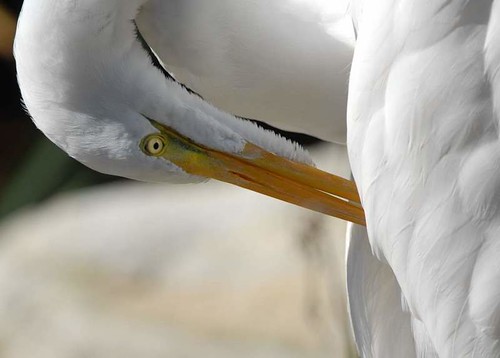tags: Common Egret, Great White Egret, Great Egret, Ardea alba, birds, mystery bird, bird ID quiz
[Mystery bird] Great Egret, also known as the Great White Egret or the Common Egret, Ardea alba, photographed in California. [I will identify this bird for you in 48 hours]
Image: Steve Duncan, February 2010 [larger view].
Nikon D200 w/ Nikkor 300mm f/4 & TC17E.
Please name at least one field mark that supports your identification.


Coincidentally, I saw one of its smaller, European cousins just yesterday, in Somerset.
I think it's a Great Egret. First of all, it looks like an Egret; general shape and colour. Based on the location, it could be a Snowy Egret but I think that the yellow bill indicates a Great Egret.
There's an outside chance it's a Chinese Egret - escaped from somewhere, or an incredibly rare visitor - except that doesn't have the pure orange bill and lores, (although there is a hint of colour there).
Simon, I believe your choice is the only white heron possibility in California with that yellow bill, although I'm not sure if the white morph of a slightly larger species can be found that far west- I think the latter is confined to Forida and the Caribbean and besides, the bill looks less heavy than as I have seen in the typical "blue" version I get around here on the east coast...
I'm having troule deciding between a great egret and a cattle egret. In Feb, the cattle egret would be out of breeding plumage, and has a yellow bill, too.
In my Sibley's, the cattle egret looks like it has a longer feathered area under the bill (longer out towards the end of the bill). The bill looks longer than I'd think for a cattle egret, but it's hard for me to tell from this close up.
It's isn't at all hard to tell that this is an INCREDIBLE image!
SimonG - Can't be Egretta thula, because the Snowy Egret has a black bill.
Ardea herodias occidentalis (Audubon), the white morph of the Great Blue Heron, still has blue lores. (I've seen that one - or else a leucistic sport of the blue morph - on Long Island, a long way from the Caribbean!)
So I agree with you and David on this one. Casmerodius albus (Linnæus), or Ardea alba to modern taxonomists. The Great Egret.
Bardiac -- a Cattle Egret would show a heavier base to a much shorter bill. The head would also be shorter and rounder. But definitely worth considering.
Hello Bardiac, a good pointer to Great (White) Egret is the extent of the gape. This goes some way behind the eye, whereas Cattle Egret and the very similar Intermediate Egret finish at the eye. This is the field mark that I use anyway.
Another Kevin,
Although I've read some descriptions varying from blue-green to pale blue (Kushland and Hancock, a snip at only $260!), I'm not so sure that "blue lores" are consistent enough of a mark for A. h. occidentalis:
white morph of the Great Blue Heron (Everglades, Florida)
Nice point, Adrian. Not something we'd have to use here too often (no Intermediate Egrets, sadly), but nice to know anyways.
And I think we can rule out Great White Heron, based on the lack of head plumes that an adult should show, and the orange culmen -- an immature Great White would show a dark culmen instead. The bill should be heavier than this bird, too.
Paul,
Although I do think this is indeed a Great Egret, I often see noted that the ead plumes on the white morph occidentalis are signficantly thinner and not always obvious, as shown below:
white morph occidentalis 1
white morph occidentalis 2
And I must admit I do not feel comfortable naming occidentalis as a "white morph" after reading David Sibley's November 2007 blog entry, "Great White"' Heron- not just a color morph, although I do wonder about the Würdemann's Heron (foreground)...
(re. comment #9- of course it should read "head plumes"!)
And just to get three in-a-row, the following research by Heather McGuire pretty much sums it up for me- she observed more white/white and blue/blue pairs than mixed-color pairs (although 17 out of the 144 pairs were indeed mixed and could really be the hybrid origin of Würdemann's) than one would expect in a randomly mating population (i.e. if the whites were just morphs)... add to that fact that they differ morphologically in several traits but also genetically, I would have to agree with McGuire that "the great white heron appears to be a good biological species."
Paul, yes I realise that you don't have to separate Intermediate, it's not a problem for us either except when we travel in the Palearctic (or a vagrant Great Egret turns up). I agree the bill looks too fine for Great Blue Heron, which is more wedge-shaped than this bird's.
David, thanks for the interesting serias of articles, very good reading.
ah, but you do get Intermediate Egrets on US soil!
Sadly, Midway Island is hard to reach. When I lived on Oahu, you needed permits (not to mention a boat or plane). Of course, I think it was still owned by the navy at the time, but the same applied to the rest of the NW chain.